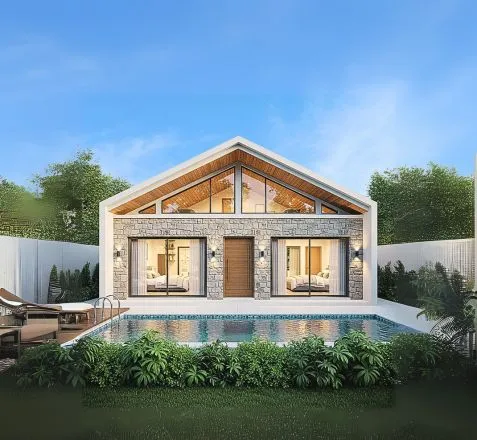In today’s rapidly changing world, homeowners are looking for housing solutions that combine style, functionality, and sustainability. The modular house has emerged as a modern answer to these needs, redefining how people build and live in homes. Unlike traditional construction, a modular home is built in sections or “modules” within a controlled factory environment and later assembled on-site. This innovative method not only speeds up construction but also ensures precision, reduced waste, and cost efficiency. With growing concerns about environmental impact and housing affordability, modular homes are becoming a mainstream option for individuals and families worldwide.

The Concept Behind Modular House Construction
A modular house is not just another prefab structure; it represents a new standard of engineered housing. Each module is crafted with meticulous attention to detail using high-quality materials, ensuring durability and design consistency. Once the modules are completed, they are transported to the building site where they are assembled to create a fully functional home. This streamlined process drastically reduces weather-related delays and labor costs compared to traditional on-site construction.
The controlled factory setting also ensures that every component meets strict quality standards, from plumbing and electrical fittings to insulation and finishes. This precision results in homes that are not only visually appealing but also energy-efficient and structurally sound. Whether it’s a small modular cabin or a multi-level modular villa, the same principles of precision engineering and design flexibility apply.
The Environmental and Economic Benefits of Modular House Design
One of the main reasons modular homes are gaining global recognition is their sustainable construction process. The factory-based production minimizes material waste, lowers energy consumption, and allows for the reuse of leftover materials. This approach significantly reduces the carbon footprint compared to conventional housing methods.
From an economic standpoint, modular houses are also more cost-effective. The shortened construction timeline means lower labor expenses and fewer delays. Additionally, because the materials are purchased in bulk for factory production, overall costs are reduced. Homeowners can enjoy a modern, energy-efficient residence at a fraction of the price of a traditional home.
Moreover, modular houses often come with advanced insulation systems, solar-ready designs, and energy-efficient windows and doors. These features not only lower utility bills but also make the house more sustainable in the long run. For those concerned about environmental responsibility, modular housing offers a perfect balance between modern comfort and ecological mindfulness.
The Versatility and Design Freedom of Modular House Architecture
A common misconception is that modular homes are limited in design options. In reality, they offer an incredible range of customization possibilities. From sleek contemporary layouts to cozy traditional aesthetics, modular construction allows architects and homeowners to bring any vision to life. Each module can be tailored to suit personal tastes, lifestyle requirements, and environmental conditions.
Modern modular homes can include spacious living rooms, open kitchens, home offices, and luxury features like rooftop terraces or energy-efficient smart systems. The design flexibility means you can start small and expand later by adding more modules, making modular housing ideal for growing families or evolving lifestyles.
The use of advanced materials and modern construction technology further enhances the structural integrity of modular houses. They are designed to meet local building codes and often exceed traditional construction standards in terms of safety and energy efficiency. This adaptability makes modular homes suitable for various terrains and climates, from urban settings to remote rural landscapes.
The Role of Technology in Modular House Innovation
Technology has revolutionized the modular housing industry, making it smarter, faster, and more efficient than ever before. Computer-aided design (CAD) and 3D modeling software allow precise planning of every detail before construction begins. This eliminates errors, improves coordination, and allows homeowners to visualize their future homes accurately.
In addition, many modular house manufacturers integrate smart home technologies directly into their builds. Features such as automated lighting, climate control, and energy monitoring systems are becoming standard components of modern modular living. These innovations contribute to greater comfort, convenience, and long-term sustainability.
The use of eco-friendly materials like recycled steel, sustainable timber, and low-emission paints further enhances the environmental value of modular homes. Combined with renewable energy options like solar panels, modular housing can move toward complete energy independence in the near future.
The Global Shift Toward Modular House Communities
Across the world, modular housing developments are reshaping how communities are built. Governments and developers are recognizing the potential of modular construction in addressing housing shortages and urban expansion challenges. These homes can be produced and assembled quickly, allowing entire neighborhoods to be developed in a fraction of the time required for traditional housing projects.
Countries like the United States, Japan, and several parts of Europe are leading the modular revolution, while emerging markets are also embracing this efficient approach to housing. As populations grow and urban spaces become limited, modular communities offer scalable, affordable, and sustainable housing solutions for future generations.
The Future Outlook for Modular House Construction
The future of modular housing looks incredibly promising. With advancements in green technology, materials science, and architectural design, modular homes are set to redefine modern living standards. As affordability, speed, and sustainability continue to dominate housing trends, modular homes are expected to become a cornerstone of residential construction.
For homeowners seeking flexibility, energy efficiency, and style without compromise, modular homes represent an intelligent investment. They embody the perfect blend of innovation, design, and environmental responsibility, offering a housing solution that meets the demands of the modern era.
The Conclusion on Modular House Living
A modular house is more than a construction trend—it is a forward-thinking lifestyle choice that combines efficiency, sustainability, and personalization. By merging technological innovation with eco-friendly practices, modular homes have proven that modern housing can be both beautiful and responsible. As awareness grows and technology continues to evolve, modular living will likely become the preferred path for those seeking smarter, faster, and greener ways to build their dream homes.

